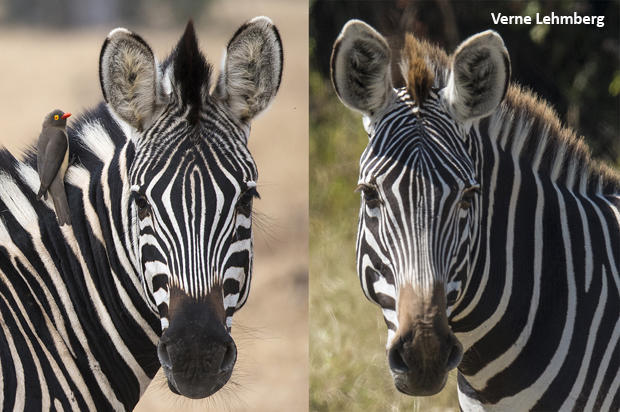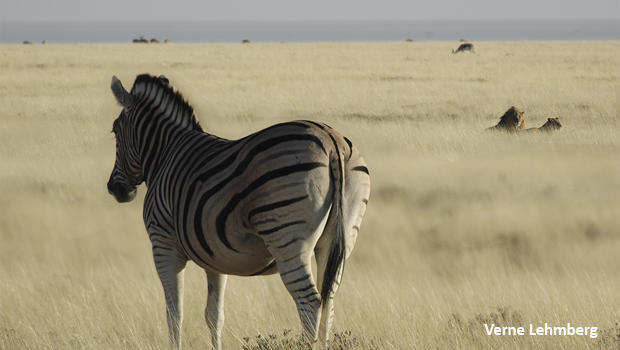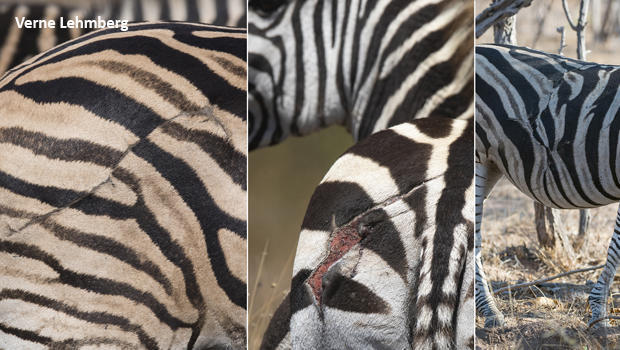Nature up close: Why do zebras have stripes?
By "Sunday Morning" contributing videographer Judy Lehmberg.
Where did zebras get their stripes? The answer to that is evolution, but that is a general answer for how any organism has the traits it has. A better question would be: "Why does a zebra have stripes?"
There are three species of zebras, all native to Africa: The plains zebra (Equus quagga), also known as the Burchell's or common zebra, is by far the most numerous and lives in southern and eastern Africa. They are mid-size between the other two species, and the males are larger than the females.
Mountain zebras (Equus zebra) live in the mountainous region along the western side of Namibia and can be found in some areas along the southern edge of South Africa. They are slightly larger than plains zebras and – opposite to the plains zebra – the females are larger than the males.
Grévy's zebra (Equus grevyi), the largest of the three species, lives in northern Kenya and a few places in eastern Ethiopia. It is the only species of the three considered endangered, although the mountain zebra is threatened. It is also the most primitive, and more mule-like than the other two, with longer, larger ears and a large, elongated head.
There have been many explanations over the years for why zebras have stripes, some more satisfactory than others. One is that because the stripes vary from one zebra to the next, they use them to recognize each other. Another is they may confuse predators because the striping blends at a distance and merges to grey, allowing zebras to be camouflaged in tall grass. The problem with that idea is that lions and hyenas can't see well at a distance, therefore they are more likely to have heard or smelled their prey than seen it.
Another variation of this idea is that a group of zebras moving close to each other might look like one large group of flickering stripes, thus making it harder for a lion to select a specific target. I don't believe that because I've repeatedly watched lions pick out the smallest zebra in a herd, usually a baby, to chase.
Some research argues the stripe may be used to cool zebras by air moving more slowly over white stripes and more quickly over black ones, creating cooling convection currents. At least one study found there are more stripes on zebras in warmer climates.
For decades some biologists have theorized a zebra's stripes allow it to evade biting insects such as tsetse flies. Due to research just published, this has proven to be the best explanation so far. Wild zebras are hard to get close to, so the researchers selected a British horse farm, which also takes in orphaned zebras, as their study site. There they could get close and film flies trying to bite zebras. They found the flies had no trouble finding the zebras, but when they got close to the stripes they couldn't manage to land on them. They came in fast, but once they got close they either hit the zebra and bounced off or never landed at all.
"Something is stopping the fly from realizing that it's close to making a landing," said Dr. Tim Caro, one of the researchers. "We don't know what that is, but stripes are exerting an effect to the very last second."
To further verify their results, Dr. Caro and his colleagues put a zebra print coat on some horses. The flies' reaction to the zebra coat was exactly the same as their reaction to real zebras – they either bounced off the horse or aborted their landing just before contact. Their reaction to the horse's head, which was not covered by artificial zebra stripes, was the same as it was to any unclothed horse. They landed and bit the horse.
This study has led to the idea that the high contrast between white and black probably tricks the fly's poor vision. They must sense movement before they know to land.
One last thing about zebras: My husband has a fascination with their scars. He likes to know which ones have been attacked by a lion but gotten away. So that means we have to examine the rear end of every zebra we see. It isn't my favorite thing to do, but it is interesting that a number of zebras have scars, while wildebeest, impala and other prey species don't. I guess they either get away scar-free, or were eaten.
Judy Lehmberg is a former college biology teacher who now shoots nature videos.
See also:
- Judy Lehmberg (Official site)
- Judy Lehmberg's YouTube Channel
To watch extended "Sunday Morning" Nature videos click here!
Recently from "Nature Up Close:






